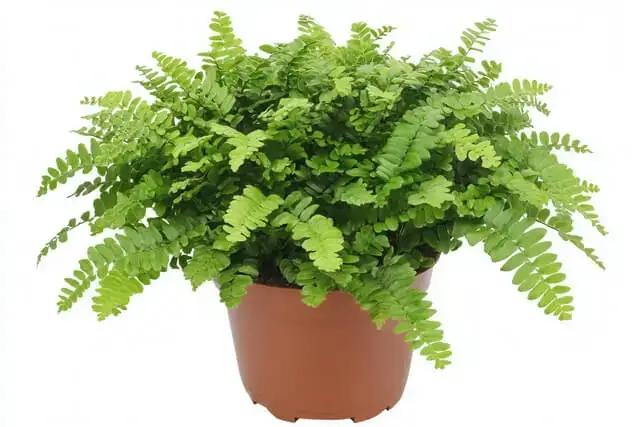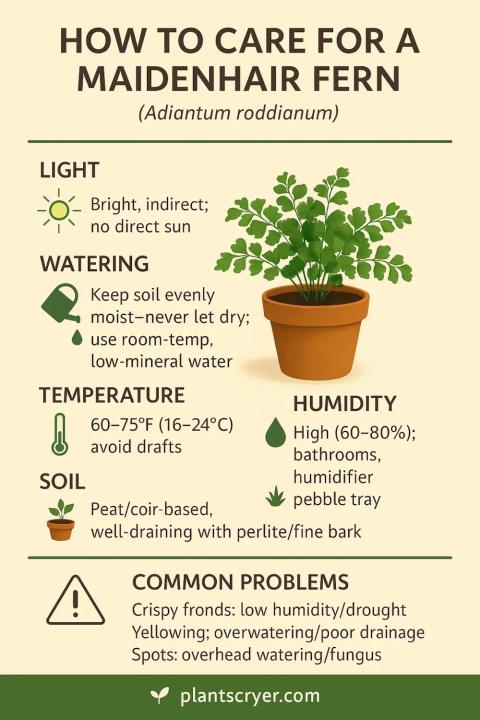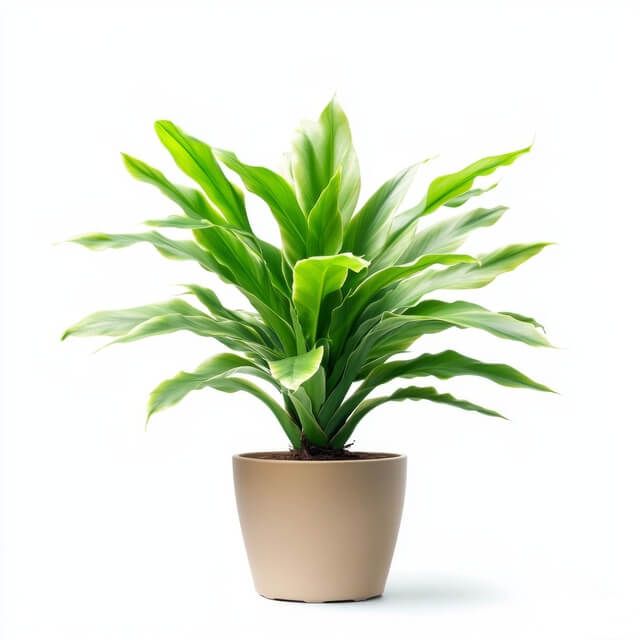Maidenhair Fern
Adiantum raddianum

The Maidenhair Fern (Adiantum raddianum) is one of the most elegant yet delicate houseplants, loved for its airy, lace-like foliage and wiry black stems. Native to tropical regions of South America, it grows naturally in shaded, humid forest floors and along rocky streambanks. Indoors, it’s famous for being a bit of a diva — rewarding attentive care with lush, cascading growth but quickly showing stress if its needs aren’t met.
Unlike hardier ferns like the Bird’s Nest Fern, Maidenhair Ferns are prized for their ornamental beauty but are best suited for plant parents who can provide consistent humidity, moisture, and gentle light. Their charm makes them a centerpiece in bathrooms, terrariums, and shaded plant shelves.
Quick Info
- Light: Low
- Water: High
- Size: 12–24 inches tall
- Humidity: High
- Temp: 60–75°F (16–24°C)
- Flowering: No
- Type: Fern
- Dog Safe: Yes
- Cat Safe: Yes
- Kid Safe: Yes
Toxicity Info
- Dog Safe: Yes
- Cat Safe: Yes
- Kid Safe: Yes
 Save
SaveCare Instructions
Light
Maidenhair Ferns prefer bright, indirect light but can also tolerate low light as long as humidity is high. Avoid direct sun, which will scorch the delicate fronds. East-facing windows or shaded north windows are ideal. If grown in a bathroom, ensure there’s at least some natural light or supplement with a grow light.
Water
This fern is extremely sensitive to drying out. Keep the soil consistently moist but never waterlogged. Water as soon as the top half inch of soil feels slightly damp rather than waiting for it to dry fully. Always use room-temperature water to avoid shocking the roots. If the soil dries completely, fronds will quickly turn crispy and may not recover.
Soil
Use a peat-based, moisture-retentive mix with good drainage. A blend of peat moss, perlite, and a small amount of compost works well. Avoid sandy or overly fast-draining soils, which dry out too quickly.
Humidity
Humidity is the most critical factor. Maidenhair Ferns thrive at 60–80% humidity, making bathrooms, terrariums, or greenhouses ideal. In regular rooms, boost humidity with daily misting, pebble trays, grouping plants together, or using a small humidifier. Dry air is the #1 killer of Maidenhair Ferns.
Temperature
Keep them in a stable environment between 60–75°F (16–24°C). They dislike drafts, heaters, and air conditioning vents.
Fertilizer
Feed monthly during spring and summer with a diluted balanced liquid fertilizer. Avoid over-fertilizing, as sensitive roots can burn. Skip feeding in fall and winter when growth slows.
Maintenance
Trim away brown or dried fronds regularly to encourage fresh growth. Rotate the plant every few weeks for an even shape. Repot every 1–2 years in fresh soil to prevent compaction and keep roots healthy.
Common Problems
Crispy, brown fronds
- Cause: Low humidity or soil drying out even briefly.
- Fix: Increase humidity, check soil daily, and avoid missing waterings.
Yellowing leaves
- Cause: Overwatering or poor drainage.
- Fix: Ensure pot has drainage holes and soil isn’t soggy. Switch to a peat-rich, breathable mix.
Drooping or sudden collapse
- Cause: Complete soil dryness, often fatal.
- Fix: Soak the pot in a basin of water for 10–15 minutes to rehydrate. Some fronds may not recover, but new growth may appear with consistent care.
Leaf spots or fungal growth
- Cause: Overhead watering or poor air circulation.
- Fix: Water at the soil level, increase airflow, and remove affected fronds.
Pests (scale, aphids, fungus gnats)
- Cause: Overly damp conditions can attract pests.
- Fix: Inspect regularly, use neem oil or insecticidal soap, and allow the topsoil to dry slightly between waterings.
FAQs
Yes, it's non-toxic to both cats and dogs.
Yes, as long as there’s some indirect natural light or a grow light.
They require high humidity and consistently moist soil. Even missing one watering can cause crisping. Try placing it in a bathroom or terrarium for more stable conditions.
If the fronds are completely crispy, trim them back and continue watering consistently. Sometimes new fronds will regrow from the root base, but not always. Prevention is key.



